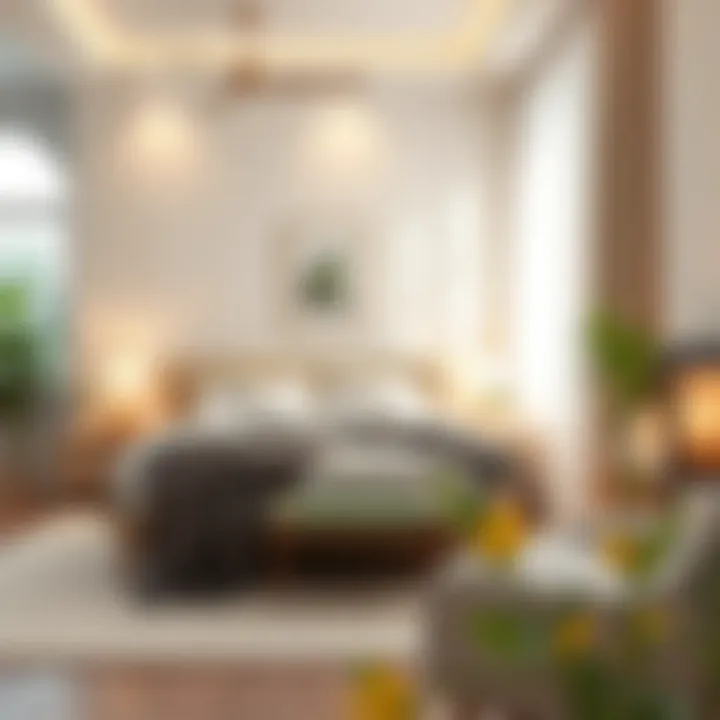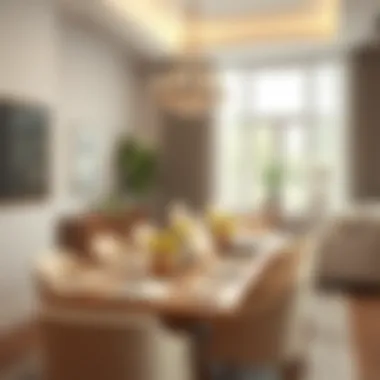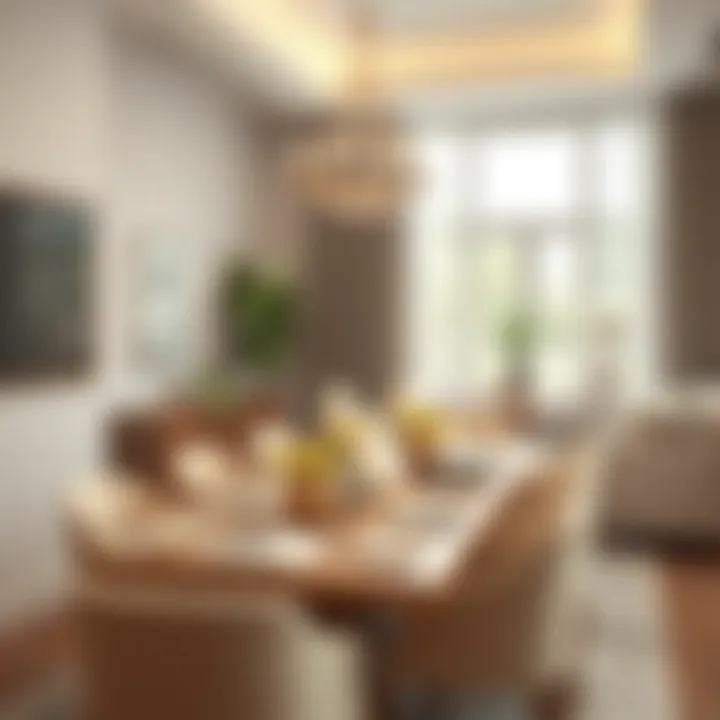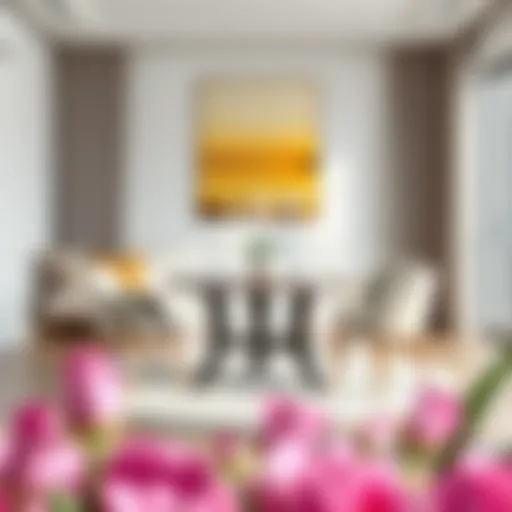The Influence of Light Decor on Living Spaces


Intro
Light decor is more than just an aesthetic choice; it's an art that can fundamentally affect how we perceive and interact with our spaces. In an era where many crave a sense of serenity and openness within their homes or workspaces, the principles of light decor provide a framework through which this desire can be realized. With appropriate techniques, a simple room can transform into an inviting sanctuary or a vibrant hub of creativity. Throughout this article, we will take an in-depth look at how light interacts with our surroundings, delving into color theories, material choices, and spatial arrangements. This exploration reveals how thoughtfully chosen light decor can elevate not only the visual appeal of a space but also its emotional resonance.
The discussion ahead is tailored for designers, retailers, homeowners, and DIY enthusiasts. Whether you're revamping a cozy living room or rethinking a bustling office, the insights you'll gain here are designed to help you craft spaces that are as functional as they are inspiring.
We’ll explore various elements that contribute to effective light decor, creating a guide that is as practical as it is insightful. Each section will unravel key concepts and innovative applications, leading us toward a comprehensive understanding of how light decor is intertwined with our daily experiences.
"Light is the building block of architecture; it can alter mood, perception, and the essence of any space."
Through this journey, be prepared to challenge conventional ideas and embrace a new perspective on how light can shape our environments. Let’s embark on this illuminating exploration together.
Understanding Light Decor
Light decor transforms spaces, playing a crucial role in how we perceive and interact with our environments. The essence of light decor is not just about brightness; it’s about crafting a mood, enhancing aesthetics, and creating a harmonious flow within a space. Designers often recognize that light can influence emotions, behaviors, and even productivity. With the right application, it can make rooms feel more expansive or snug, reflecting the personality of the inhabitants.
When discussing light decor, several elements come into play. Color palettes are paramount; light hues can open up a space while darker tones can create warmth. The choice of materials also greatly affects how light interacts with surfaces—think glass or polished wood versus heavy textiles. All these components contribute to an inviting atmosphere, one that balances functionality through illumination and visual appeal. Understanding light decor goes beyond mere aesthetics; it can foster a sense of tranquility, making living spaces more livable and welcoming.
Definition and Overview of Light Decor
Light decor refers to the deliberate integration of light elements—both natural and artificial—into a space’s design. It encompasses how light influences colors, textures, and overall decor style. In essence, it’s the artful manipulation of lighting to achieve visual comfort and enhance aesthetic beauty.
At its core, light decor merges practical lighting solutions with design aesthetics. Instead of treating lighting merely as a functional necessity, designers embrace it as a transformative element that affects both the psychological and visual dynamics of a space. For instance, a thoughtfully placed lamp can draw one’s eye, enhancing a specific area, while also contributing to the overall ambiance of a room.
Historical Context and Evolution
Light decor has evolved significantly over time, mirroring changes in technology, design philosophies, and social trends. In earlier centuries, spaces were illuminated by candles or oil lamps, creating an atmosphere characterized by shadows and flickering light. The ambiance was cozy, albeit sometimes impractical for everyday tasks.
With the advent of electricity in the late 19th century, a seismic shift occurred. Electric bulbs offered brighter, more reliable light, enabling designers to rethink space entirely. The mid-20th century saw the introduction of modernism, where open spaces and ample light became desirable. Natural light was increasingly valued, shaping architectural designs that aimed to blur the lines between the indoors and outdoors. Now, with advancements in smart technology, light decor continues to evolve; adjustable lighting systems allow for customizable environments, responding to the needs of the moment.
This historical evolution reinforces the idea that light decor is not static. It adapts to cultural contexts, technological improvements, and changing lifestyles. As we move forward, understanding this evolution allows designers and homeowners alike to appreciate the subtleties of lighting in its broadest sense.
The Philosophy of Light in Design
The interplay between light and decor is a topic that holds significant weight in the structure and feel of a space. Understanding the philosophy behind light in design can enhance living environments, making them more enjoyable and functional. The careful consideration of light not only affects aesthetics but also impacts mood, perception, and even behavior. This section will shed light on the psychological effects of light (pun intended) and the balance between natural and artificial sources.
The Psychological Effects of Light
Light has a profound impact on human psychology.
- Natural light, for instance, can invigorate the senses. It promotes a sense of well-being and supports mood regulation. Research has shown that exposure to sunlight increases serotonin levels, that feel-good chemical in the brain.
- Conversely, too little light can foster feelings of sadness and lethargy. This effect is often seen in our inclination towards cozy, dimly lit environments when the sun dips below the horizon.
In decorating spaces, choosing light colors and integrating glass elements can enhance the effects of natural light. For example, a room painted in soft pastels can reflect more sunlight, making the space feel larger and airier. Likewise, strategic lighting placements can animate shadows and highlights, adding depth and interest.
"The way a room feels when lit properly can make all the difference between a lively gathering space and a bleak, lifeless area."
Thus, it's imperative to consider how the lighting aligns with the intended function of each room. For instance, softer lighting in bedrooms cultivates calm, while brighter environments in kitchens stimulate activity and focus.
Balancing Natural and Artificial Light
In any living space, achieving harmony between natural and artificial light is key. Many designers strive for this balance to create a holistic environment that serves both form and function. Here’s a closer look at the elements that come into play:
- Assess Natural Light Sources: Take a good look at which areas of your home benefit from natural light and when. Rooms facing south typically bask in sunlight throughout the day, while those that face north receive limited rays. This assessment will guide your decisions on placement and types of artificial light.
- Layering Light: Use different types of lighting—for example, ambient, task, and accent—to complement natural light. Ambient light might come from ceiling fixtures, while task light could be from lamps placed on desks or reading nooks.
- Timing and Control: Consider investing in dimmers and smart lighting systems that adjust brightness based on time of day or activity. This control helps maintain the right mood and efficiency in energy consumption.
- Using Window Treatments Wisely: Sheer drapes can diffuse strong sunlight, allowing for a softer glow while providing some privacy. Heavy drapes, on the other hand, can block out light altogether when desired for a cozy evening in.
Finding that perfect balance is akin to walking a tightrope—it requires sensitivity and insight into how light affects your daily life. By nurturing both natural and artificial elements, you can transform a space into one that feels alive and inviting, regardless of the time of day.
Key Elements of Light Decor
The concept of light decor encompasses various components that collectively shape the ambiance of a space. Understanding these key elements is crucial for designers, retailers, homeowners, and DIY enthusiasts alike. Each element plays a distinct role in maximizing the effectiveness of light within a space. By focusing on the details, such as color palettes, material choices, and furniture pieces, you can create environments that not only look visually appealing but also foster feelings of openness and tranquility.


Color Palettes That Reflect Light
When it comes to color in decor, light raises the stakes. Colors not only affect aesthetics but also influence mood and perception. Lighter shades—think whites, soft beiges, and pastel hues—naturally gather light, making spaces appear larger and inviting. Reflective colors, such as glossy finishes or metallic tones, help bounce light around, further enhancing brightness.
"Choosing the right color palette is like setting the stage for a performance; it can change the entire atmosphere of a room."
Here are a few strategies for effectively utilizing color in light decor:
- Choose soft, airy colors: Shades like light gray and creamy whites can breathe life into any surface.
- Incorporate reflective surfaces: High-gloss paint or well-placed mirrors assist in reflecting light, amplifying the overall brightness of the room.
- Mix light and dark carefully: Balance can create depth; consider using darker tones in small doses for contrast while keeping surrounding areas light.
Incorporating these palettes is not merely a color choice but a strategic decision that impacts how a space is visually and psychologically perceived.
Material Choices: Transparency and Lightness
Material selection serves as a significant cornerstone in achieving the essence of light decor. Transparent or light materials facilitate the flow of light, thereby elevating the space. Glass, for example, is a classic choice, whether it's used in furniture, lighting fixtures, or decorative accents. This material's ability to make elements feel less heavy simplifies visual clutter and enhances clarity in a space.
Here’s how to incorporate materials effectively:
- Opt for transparent furniture: Acrylic tables or glass shelving can create an illusion of more space and light.
- Incorporate sheer textiles: Curtains made out of lightweight fabrics allow natural light to filter through, keeping the room bright while offering privacy.
- Use light wood finishes: Light-colored woods—such as birch or pine��—add warmth without overwhelming the senses.
Each material, chosen wisely, can contribute to a layout that promotes an uncluttered, airy vibe.
Furniture and Fixtures That Enhance Light
The furniture and fixtures within a room play an essential role in the overall light decor. Choosing pieces that enhance, rather than obstruct, light can significantly impact the atmosphere. For instance, open and airy designs allow for maximized light flow, while strategically positioned lighting fixtures can draw the eyes and create focal points throughout the space.
Some tips for optimizing furniture and fixtures include:
- Select low-profile furniture: This gives an unobstructed view across the room, allowing light to travel freely.
- Use strategically placed lamps: Table and floor lamps with soft, diffused light can add warmth without creating shadows.
- Incorporate decorative fixtures: Consider using pendant lights or chandeliers that reflect light; this not only brightens but also serves as art.
In sum, the right furniture can act as a stage for light to dance across a room, creating a harmonious living environment.
Integrating these key elements effectively showcases light decor's potential to transform spaces. They create a warm, inviting atmosphere that goes beyond visual appeal. Collectively, they breathe life into spaces while ensuring functionality and style coexist.
Integrating Light Decor into Your Space
In today’s world, the significance of light in interior spaces cannot be overstated. Integrating light decor into your living environment is not just a stylistic choice; it is a critical element that influences mood, perception, and functionality. By thoughtfully incorporating light decor, you create an atmosphere that enhances both aesthetics and usability. This section delves into specific elements, benefits, and considerations surrounding the integration of light decor into various spaces.
Techniques for Maximizing Natural Light
Harnessing natural light is one of the most effective ways to enliven a space. Here are some techniques that can dramatically enhance the flow of natural light:
- Choose Light Colors for Walls: Lighter shades like whites, pale blues, or warm pastels reflect light, making a room feel airy.
- Window Treatments: Opt for sheer curtains or blinds that allow light to filter in while maintaining privacy. Avoid heavy drapes that block sunlight.
- Strategic Placement of Mirrors: Positioning mirrors opposite windows can bounce light around the room, increasing brightness and creating an illusion of more space.
- Use Open Space Concepts: In open floor plans, the absence of barriers allows light to traverse freely from one area to another, making the environment feel interconnected and bright.
Natural light contributes to a person’s sense of well-being and can even aid in enhancing productivity. Ensuring your space can take advantage of this resource is a game changer.
Strategic Use of Mirrors and Reflective Surfaces
Mirrors and reflective surfaces are essential tools in the light decor toolkit. They do not just serve the purpose of reflection; they amplify the light, both natural and artificial, creating a more luminous environment. Here are some strategic ways to employ them:
- Placement: Hang mirrors where they can capture and reflect light from windows or light fixtures. For instance, a large mirror on a wall opposite a window can visually double the light, transforming the room’s atmosphere.
- Layering Textures: Use mirrored surfaces alongside contrasting textures, such as wood or woven textiles, to create depth and intrigue within the space.
- Furniture Choices: Consider furniture with reflective finishes, like glass and metallics. These pieces not only visually expand a space but also contribute to the overall light dynamics.
"Well-placed mirrors can act as a second window, bringing the outdoor light inside."
Mirrors should not only be viewed as decorative items but as vital elements in achieving a bright and welcoming home. Integrating these strategies into your aesthetic approach can significantly affect how spaces are perceived and experienced.
Room-Specific Approaches to Light Decor
In the realm of interior design, applying light decor principles differently in various rooms not only enhances the aesthetic appeal but also influences the functionality of each space. Each room serves a unique purpose and requires thoughtful consideration to harness light effectively. By customizing decor to fit the specific environment, homeowners can cultivate not just beauty, but also comfort and utility. This exploration digs into how tailored strategies can elevate the ambiance of living spaces, providing a personalized connection with light.
Living Rooms: Creating Inviting, Open Spaces


The living room is often the heart of a home, where family and friends gather. Thus, it demands decor that promotes warmth and openness. Natural light can be accentuated through sheer window treatments, allowing for a soft glow that feels inviting without compromising privacy. Using light colors on the walls, like soft whites or gentle pastels, amplifies brightness and makes the room feel larger.
Essential furniture pieces need to be arranged to facilitate conversation and views to the outside. A well-placed mirror can reflect daylight, adding to the room’s spaciousness while creating an illusion of depth.
"Creating inviting spaces isn’t just about aesthetics; it’s about making people feel at home."
Considerations for Living Room Light Decor:
- Opt for floor lamps and sconces that emit warm light.
- Add a statement chandelier that not only illuminates but acts as a centerpiece.
- Use artwork that complements the natural light flow, creating harmony between decor and environment.
Kitchens: Bright and Functional Areas
Kitchens thrive on light. A bright kitchen can invigorate creativity and efficiency, making meal preparation a delightful experience. The right lighting in a kitchen is essential, not just for function but for mood. Emphasizing task lighting under cabinets can help eliminate shadows from countertops while providing an inviting glow.
Choosing light-colored cabinetry and countertops, such as whites or light yellows, can enhance the natural light that pours in through windows, contributing to an area that feels airy and spacious. Adding reflective materials like stainless steel appliances can further amplify light distribution.
Key Elements for Kitchen Light Decor:
- Install pendant lights above the island or dining areas for focused illumination.
- Use dimmers for adjustable ambiance during different cooking and dining scenarios.
- Incorporate natural elements, such as plants near windows, to bring a liveliness that complements the kitchen environment.
Bedrooms: Tranquility and Restfulness
Creating an atmosphere of relaxation is critical in bedrooms, where restful sleep is paramount. Soft, diffused lighting promotes a calm environment. Window treatments that allow soft light while blocking harsh rays are ideal, helping maintain a balanced light throughout the day.
Color choices should lean towards soothing tones—think muted blues or gentle greens—to evoke tranquility. Additionally, bedside lamps with warm bulbs can provide gentle illumination for nighttime reading without overwhelming bright lights.
Important Considerations for Bedroom Light Decor:
- Layer lighting with dimmer switches to control intensity.
- Use textured fabrics for curtains that absorb sound and light, enhancing a peaceful atmosphere.
- Consider light fixtures that provide adjustable settings, allowing personal preference for different activities, whether sleeping, reading, or working.
Home Offices: Enhancing Productivity Through Light
In a world where many are working from home, an effective home office is crucial for productivity. Good lighting can significantly impact focus and mood; thus, both natural and artificial light need to be harnessed effectively. Positioning a desk near a window to take advantage of daylight can lift spirits and help combat fatigue.
Task lighting becomes important here as well. Adjustable desk lamps with LED bulbs can provide concentrated light where it's needed most without casting shadows. A color palette with soft whites and muted colors helps keep the mind clear and focused, while plants can bring a touch of life and vitality into the workspace.
Tips for Home Office Light Decor:
- Install workplace fixtures with adjustable brightness to suit your tasks.
- Regularly clean windows to maximize natural light entry.
- Use a balance of lighting sources, including indirect light sources that create a well-lit environment without harshness.
Integrating room-specific approaches to light decor can breathe new life into living spaces. Through thoughtful attention to lighting, one can create a harmonious blend of beauty and functionality throughout the home.
The Role of Accessories in Light Decor
When it comes to designing a space that feels both inviting and serene, the accessories chosen to complement light decor play an integral part. Accessories often function as the finishing touches, filling gaps in the decor while also enhancing the overall luminosity of a room. Whether it’s a strategically placed lamp or a series of reflective wall art, these elements can significantly affect how light interacts with the environment. Not only do they add character, but they also serve practical purposes, guiding the flow of natural and artificial light throughout the space.
Lighting Fixtures: Chandeliers to Wall Sconces
Lighting fixtures stand out as key accessories within light decor. From elegant chandeliers that hang gracefully from ceilings to wall sconces dotting the sides of rooms, these pieces can drastically alter the mood of a space.
- Chandeliers: These dazzling central features blend art and function. A glass chandelier, for example, can scatter light beautifully, creating dancing reflections across walls. Different styles—from contemporary designs to vintage models—can complement the overall aesthetic of the room, ranging from modern minimalism to rustic warmth.
- Wall Sconces: Not just for lighting, wall sconces can also serve as a decorative element, adding depth and interest to walls. They come in various shapes and sizes, providing both direct and ambient light. Choosing sconces that match the room’s theme adds layers of texture to the decor.
- Table and Floor Lamps: These add versatility to your lighting options. They can provide focused light for tasks and a warm glow for relaxation. Selecting lamps with mirrored or metallic finishes enhances light reflection, contributing to the airy feel of a room.
Some considerations when selecting lighting fixtures include:
- Size and Scale: The size of the fixture should harmonize with other elements in the room. A large chandelier can be a focal point, but it shouldn’t overwhelm the space.
- Light Quality: Warm lights create a cozy atmosphere, while cooler tones tend to make a space feel more clinical. Choose according to the desired ambiance.
- Design Consistency: Ensure the style of the lighting matches the rest of the decor for cohesion.
"Good lighting is just as important as good design; the two work in tandem to evoke emotion and function within a space."
Textiles: Choosing Fabrics for Reflection and Absorption
Textiles are another vital component that can elevate light decor. The right fabrics can either absorb or reflect light, influencing the overall brightness and energy of a space.


- Reflective Textiles: Fabrics such as silk or satin can bounce light around the room. Use these in throw pillows, curtains, and tablecloths to enhance the ambient light. Light, airy drapes can filter sunlight beautifully, allowing it to play softly across floors and walls.
- Absorbent Fabrics: On the contrary, heavier materials like velvet or wool can deepen tones and create a cozy feel, perfect for spaces where one seeks relaxation. While they may absorb light, they can ground the overall design, ensuring that it doesn’t feel too stark or bright.
Some tips for selecting textiles include:
- Color Matters: Lighter colors reflect more light, while darker shades absorb it. Consider how the color of the fabrics contributes to the desired ambiance.
- Layering: Mixing different fabrics adds dimension and richness. For example, a light linen curtain paired with heavier upholstered furniture creates a balanced look.
- Maintenance: Keep in mind the fabric’s durability and ease of cleaning, especially in high-traffic areas, to ensure longevity in design.
Maintenance of Light Decor
Maintaining light decor is a crucial aspect of ensuring that your living space continues to radiate beauty and functionality. Just as a painter does not let their canvas collect dust, so too must homeowners care for the elements that bring light into their homes. Regular maintenance not only prolongs the aesthetic appeal but also reinforces the psychology of light and space—making rooms feel more welcoming and expansive.
One of the main benefits of maintaining light decor is that it can enhance the overall quality of the environment. Light-reflective surfaces like mirrors, for example, can lose their charm if they become dull from grime. In kitchens, light fixtures can flicker when dirty, disrupting the cheerful ambiance you aim to create. By dedicating time to upkeep, you can ensure the mood set by the lighting aligns with the intended emotional impact of your spaces.
Professional vs. DIY Cleaning Techniques
When it comes to cleaning light decor, you have options that range from professional services to do-it-yourself methods. Each has its upsides depending on the situation.
- Professional Services: Hiring a cleaning service can be beneficial for larger fixtures such as chandeliers or complex lighting installations. They usually have the right tools and expertise to clean hard-to-reach areas without risking damage.
- DIY Techniques: Tackling cleaning on your own can save costs. For instance, a simple solution of vinegar and water can work wonders on glass fixtures, cutting through grease and keeping them clear.
- Use a soft cloth to avoid scratching sensitive surfaces.
- Avoid abrasive cleaners that can tarnish or damage finishes.
The choice between professional help and DIY often comes down to your comfort level and the complexity of the task. If you’re confident with a step ladder and a cloth, get after it. Otherwise, shell out a few bucks for an expert.
Long-Term Care for Light Decor Elements
Long-term care for light decor elements includes regular upkeep and thoughtful choices in materials and designs. Investing in durable fixtures that resist wear can pay off significantly. Here are some pointers:
- Material Selection: Opt for elements made from high-quality materials; metals like stainless steel or brass naturally lend longevity and require less maintenance.
- Regular Inspections: Periodically check for wear and tear. A quick inspection every few months can help spot issues before they escalate.
- Environmental Factors: Be mindful of your environment. For example, coastal homes may require different upkeep due to salt and humidity exposure, while urban dwellers might deal with more dust.
In essence, taking the time to properly care for your light decor not only preserves their beauty but also contributes positively to your overall living experience. This approach promotes not just an aesthetic appeal but also a functional and emotionally uplifting environment, underpinning why maintenance of light decor should be a priority in every household.
Trends in Light Decor
Staying abreast of trends in light decor is crucial for both aesthetic appeal and functional efficiency in living spaces. This section hones in on the evolving landscape of light decor, emphasizing its significance in modern design. Focusing on specific elements allows homeowners, designers, retailers, and DIY enthusiasts to make informed decisions that enhance the luminosity and overall atmosphere of their environments.
Current Trends Shaping Light Decor
As we navigate the world of light decor, several current trends stand out, capturing the attention of design enthusiasts. These trends not only elevate spaces but also reflect the shifting preferences towards sustainability and personalization.
- Smart Lighting Solutions: Technology is at the forefront, with smart lighting systems becoming increasingly popular. Users can control the intensity, hue, and even the timing of their lighting using mobile apps. This functionality not only caters to busy lifestyles but also allows for customization that aligns perfectly with the mood or occasion.
- Emphasis on Biophilic Design: Bringing nature indoors is not just a passing trend; it's a rising philosophy. Natural light is prized, with designs that open spaces to sunlight while incorporating green plants that thrive in luminosity. This approach establishes a vital connection between indoor areas and the natural world.
- Layered Lighting: A well-lit space now features layers of light—from ambient to task to accent lighting. This technique creates depth, making areas more inviting and versatile. Think floor lamps beside sofas for reading, sconces along hallways, and pendant lights over dining tables.
- Sustainable Material Choices: The eco-conscious consumer is favoring fixtures made from recycled or sustainable materials. Whether it’s bamboo light shades or LED bulbs, light decor is evolving to include items that minimize environmental impact.
- Warm Color Tones: Cool white lights have taken a backseat, making way for warmer, more inviting tones. Shades of amber and golden light have become the norm, creating cozy atmospheres in homes. This shift aligns with the growing desire for spaces that feel more like a sanctuary.
Future Directions and Innovations
The future of light decor is teeming with innovations that promise to push the boundaries of design further. As technology advances and our understanding of well-being evolves, the following trends are likely to gain traction:
- Integrating Augmented Reality (AR): Imagine using your smartphone to visualize how different lighting setups would look in your space before making a purchase. AR technology has the potential to revolutionize the way we approach light decor.
- Advanced Energy Efficiency: Future lighting solutions will likely feature improved energy efficiency. Expect to see advancements in LED technology that provide brighter lights with even less energy consumption—making them better for wallets and the planet.
- Human-Centric Lighting: As our understanding of the effects of light on mental health increases, designers might focus more on human-centric lighting that adjusts throughout the day to support circadian rhythms. This approach promotes well-being by mimicking natural light patterns.
- Smart Home Integration: As homes become smarter, the lights will too. Seamless integration with home automation systems will enable lights to not only change at the touch of a button but to interact with other elements, like adjusting temperature or security systems based on occupancy.
- Personalized Lighting Experiences: Far from one-size-fits-all, the future will cater to individual preferences, potentially using AI to analyze users’ habits and suggest optimal lighting scenarios tailored to their lifestyle and needs.
The interplay between technology and design in light decor signifies broader societal shifts—an acknowledgment of our evolving requirements for comfort, sustainability, and aesthetic appreciation. Staying informed about these trends ensures spaces remain vibrant and livable.
In summary, following the trends in light decor is essential for creating functional and beautiful living spaces. By embracing both current details and future directions, designers and homeowners alike can craft environments that are not only pleasing to the eye but also supportive of our well-being.
Closure
In closing, this exploration of light decor reveals its vital role in redefining living spaces. The thoughtful integration of light elements enhances not just aesthetics but also the functionality and emotional resonance of a home. By understanding and employing key concepts—such as maximizing natural light, choosing reflective materials, and selecting appropriate color palettes—individuals can transform their environments into sanctuaries of comfort and elegance.
Summary of Key Points
The key points discussed throughout this article underscore several fundamental aspects of light decor:
- Definition and Evolution: Understanding light decor's development over the years enriches one’s appreciation of its contemporary significance.
- Psychological Effects: Light’s influence on mood cannot be overstated; a well-lit space promotes positivity and well-being.
- Element Choices: The right materials, colors, and furnishings can create an expansive and inviting atmosphere.
- Techniques for Integration: Practical methods for maximizing light, such as strategic placement of mirrors and light fixtures, are essential for any decor project.
- Room-Specific Strategies: Tailoring the decor approach for different spaces (living rooms, kitchens, etc.) ensures that each area of the home serves its purpose effectively.
The Lasting Impact of Light Decor in Living Spaces
Light decor's impact is profound and enduring. As homes evolve, the proper use of light can contribute to sustainable living, especially as more people become conscious of energy consumption. By prioritizing design principles that enhance natural light and utilizing energy-efficient fixtures, homeowners make choices that benefit both their environment and their well-being.
Moreover, light decor offers a unique capacity to adapt to various design trends. As societal preferences shift, the principles of light decor remain relevant, guiding future innovations in interior design.
Employing light decor is not merely about visual appeal; it’s a commitment to creating spaces that resonate with authenticity and comfort. Through careful consideration of light in design, one can achieve an ambiance that not only meets aesthetic desires but also nurtures the spirit.















